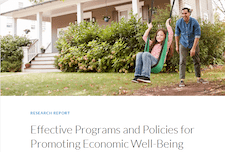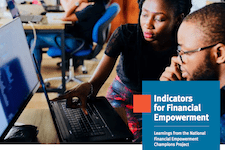Discover financial empowerment resources
Discover financial empowerment resources
The external evaluation firm, Taylor Newberry Consulting, evaluated the Benefits Wayfinder between June 2022 and January 2024. This infographic showcases the feedback received based on feedback collected from 500 users and over 35 organizations across Canada. Impact: L'orienteur en mesures...

The National Financial Empowerment Champions (NFEC) Project supported leading non-profit community organizations and their local partners to develop, implement and scale proven financial empowerment (FE) interventions across Canada with the aim of improving the financial well-being of over one...

This report was originally developed to support the work of Feeding America and its member food banks in exploring interventions that support households’ economic well-being. Such strategies can be valuable not only for organizations serving households facing food insecurity, but for agencies and...

This resource offers a set of common indicators that community organizations can use to measure the reach and impact of their financial empowerment (FE) programming. It is intended for any community organization that works to foster greater financial well-being for economically disadvantaged...

The Collaborative to Advance Social Health Integration (CASHI) is composed of a community of 21 innovative primary care teams and community partners committed to increasing the number of patients, families and community members who have access to the essential resources they need to be healthy....

Comprehensive research on microfinance and subsidy shows that virtually all microfinance institutions are subsidized, but these subsidies are small. There are two clear paths for increasing microcredit’s impact through continued investment: » Lowering the cost of microcredit by lowering...
For financial educators and others who help people with decision-making, there is evidence that providing financial rules of thumb to consumers can work better than more detailed and complex financial education in some situations. To further explore the potential of rules of thumb for financial...
The Omega Foundation commissioned this research to better assess the influence of education savings and the federal government’s savings incentive grants for saving on post-secondary access. Our hope was to clarify the facts which have until now been largely obscured. This information gap has...
Individual development accounts (IDAs) help low-income families save by matching their personal savings for specific investments, such as a first home, business capitalization, or higher education and training. The Assets for Independence (AFI) program is a federally supported IDA grant program...
In 2008, research conducted by Omega revealed that high-income families took advantage of Canada’s programs to encourage education savings at four times the rate of lower-income families. The findings also showed that only 16% of eligible Canadian children had received their CLB. In response to...
Recognizing the potential of financial coaching to improve the well-being of consumers, the Consumer Financial Protection Bureau (CFPB) commissioned a rigorous study on the impact of financial coaching programs.1 Using a randomized controlled trial design, this study allows, for the first time, a...
We present the results of a large field study exploring consumers’ use of the Reserve “set aside” feature on the American Express (the company) Serve prepaid card. The study aimed to address two key questions: 1) Can certain strategies encourage consumer saving behavior; and 2) Is saving...
In 2012, The Financial Clinic (the “Clinic”) and Branches had the opportunity to influence the emerging financial coaching sector by putting its philosophies and model to test through a random control trial study report titled “An Evaluation of the Impacts and Implementation Approaches of...
Promotion of high school students’ access to post-secondary education is a major goal of Canadian governments, in part because of its increasingly important role in helping individuals attain social and economic success. Yet, uncertainty remains as to the best policy interventions to encourage...
In this report we use a set of indicators that measure health risks, health care and health outcomes, and through these indicators we see the link between income and health – how income impacts health, and how health impacts income. The results reveal a tremendous opportunity to make life better...
The FAPS model is grounded in a social justice approach to support the financial stability of marginalized people, with several inter-related components including direct service delivery, public education and policy advocacy. This report focuses on the service delivery component of the FAPS model,...
The Family Self-Sufficiency (FSS) program was established by Section 554 of the Cranston-Gonzalez National Affordable Housing Act of 1990 to help residents of public housing and participants in the Housing Choice Voucher program become self-sufficient through education, training, case management,...
Financial counselling may be an effective way to improve individuals’ financial behaviour and outcomes. However, its impacts have not been adequately studied. Previous studies show weak positive effects of counselling, but are subject to a number of limitations. This study, a collaboration...
EPIC’s first issue brief, “Income Volatility: A Primer,” was a comprehensive literature review of what is known about the prevalence, causes, and impacts of income volatility. This second brief looks at managing income volatility at both the household and societal levels. It presents a...
